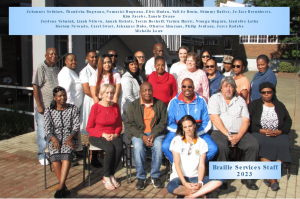
Braille Services Division
Seventieth Anniversary
Blind SA is funded by:

Foreword by Blind SA CEO

On 26 October 2023, Founders Day, Blind SA celebrates the 77th commemoration of its establishment in 1946. On the same day, Braille Services, a division of Blind SA, will celebrate the seventieth year of its existence. Originally known as the “Braille Transcription Bureau”, Braille Services was formed on 1 August 1953 in Johannesburg.
During the past seven decades, the governance of Braille Services was headed by Dr Walter Cohen, Christo de Klerk, and Eric Gama whilst the operational management was led by Ernest Kruger, Antonie Zeelie, and Philip Jordaan.
Braille Services was the flagship of Blind SA producing over 2.5 million braille pages annually and during the past two years it was expanded to include all accessible formats such as large print, Daisy, audio, and electronic formats.
The development of text-to-speech (TTS) in all South African languages by Blind SA will enable access to reading books and information for screen readers.
Our grateful appreciation is extended to the Department of Sports, Arts and Culture, the hundreds of volunteers, employees and philanthropists who ensured that the basic philosophy of providing braille and other accessible formats at an affordable cost and at a reasonable time is maintained.
A special word of thanks to Daan van Niekerk, Stafie Pelser, Philip Jordaan, and the President of Blind SA, Ntshavheni Netshituni, for their input in making this publication possible and as informative and interesting as it is.
We look forward to exciting and innovative times in the coming decades.

Jace Nair
CEO Blind SA
Celebrating 70 Years!
On 26 October 2023, Blind SA’s 77th birthday, Braille Services celebrates the 70th anniversary of its humble beginnings! What started out as a small one-person operation in 1953 is now South Africa’s largest braille printing press, producing around 2 million braille pages annually in eleven official languages.
As a division of Blind SA, Braille Services reports to the Committee for Accessible Publications, Equipment and Assistive Devices (CAPEAD) Committee, it was first chaired by Mr Christo de Klerk, vice president of Blind SA, and currently by Mr Eric Gama, a visually impaired teacher at Bartimea School for the Blind in the Free State. For many years, Braille Services produced braille only, but since moving to new premises in Alrode, its services were expanded to include large print and Daisy material.
On 13 December 2022 Braille Services received its second “Certificate of Endorsement” from the South African Braille Authority for the period 2023-2025.
With an ad hoc grant from the National Department of Sport, Arts and Culture, Braille Services is able to produce subsidised braille for blind individuals and students, compile, produce and distribute three monthly magazines, Braillorama, Braille Trumpet and Blind SA News, and one quarterly Parents Newsletter in electronic format. The grant was first received during the start of our democratic era in the mid-1990s, and every year since.
During Blind SA’s 76th birthday celebrations in 2022, the newly installed recording studio was named The Irene Mashele Audio Studio, while the braille printing press was named the Reuben Radise Printing Workshop. The unveiling was done by close family members of the persons so honoured.


The Early Days
During the meeting of the Head Committee of the South African Blind Workers Organisation (SABWO) of 17 to 19 December 1952, a decision was taken to request the establishment of a braille transcription service for the blind by the South African National Council for the Blind (SANCB).
After much deliberation, the Braille Transcription Bureau was established by SABWO on 1 August 1953. The Terms of Reference for the Bureau, as approved by SABWO Central Management during 1958, stated the purpose as “to provide in the need for braille irrespective of the individual, religious belief, race or institution.”
Mr Ernst Kruger was appointed as the Director, while his wife Monica was the first voluntary braille typist, working from their kitchen in a flat in Hillbrow, Johannesburg. Dr Walter Cohen, previous chairperson of Braille Services, later said that the service was started with only four pounds and seventy shillings!
In its first ten years, braille was produced manually on a Stainsby brailler, a small portable braille typewriter. Because no means of duplication existed at the time, the emphasis was on the production of single copies mainly for personal use. The first complete work produced was for Mr JC Harmse, “Konstitusie van die Nationale Party van Transvaal” in two volumes, a copy of which is proudly displayed in the Antonnette Botha Braille Museum at Blind SA House.

PHOTO The Stainsby braille writer, similar to the one used by Monica Kruger, on display in the ABBM museum
To make provision for multiple copies, a “Crabb” braille machine was imported from England. With it, braille was written on a light gauge double metal sheet, from which a limited number of paper braille duplicates could be made, using a washing machine mangle. The process was slow, laborious and costly.
SABWO’s first full-time employee, Mrs Elize Venter, started on 2 February 1960 as an administrative officer and on 15 January 1962 Angelique Wessels (née van der Spuy; visually impaired) became the first braille transcriber and proofreader. Mr Antonie Zeelie, a braille transcriber from the School for the Blind in Worcester, joined the team on 1 July 1963 as Head Printer. Shortly afterwards, a messenger, Mr Reuben Radise, was appointed and he later became the Head-of-Department: Printing Press.
On 22 August 1963 a joint management committee was established between SABWO and SANCB and the Braille Transcription Bureau was renamed as Braille Services, with Dr Walter Cohen as first chairperson (1963-1980) and Mr Ernst Kruger as Director (1963-1996).
In 1964 two power driven machines, the German “Marburger” and British “Stereotyper”, with which braille was written on heavy gauge aluminium sheets, were acquired. This introduced a much faster process and a virtually unlimited number of copies could be produced on an electric-powered “Jurine” platen press.
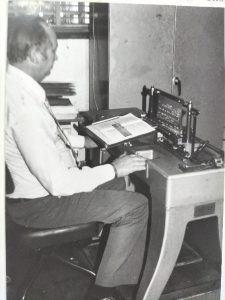
PHOTO Mr Antonie Zeelie, Braille Services manager from 1963-1996, embossing a braille master plate with the English-manufactured BEM No. 7 (Braille Embossing Machine). It was similar to the machines used by Pioneer Printers in Worcester at the time. Duplication was done on a French-manufactured Jurine platen, still in use today! These machines were imported by Evelyn Haddon from France in July 1964 at a cost of R4 000.
African-Language Braille

PHOTO Mr Mandla Ralph Mncube, our first African braille transcriber, brailling a book on the German-manufactured “Marburg Braille Stereotyper” (Photo: 1968)
The first African-language braille was produced in the 1960s, and the first African-language Bible book produced in braille was the Gospel of Luke in North Sotho, handed to Ds Loots from The Bible Society in SA on 24 June 1972.

PHOTO Mr Mathomuhle Khwela and his print proofreader reading newly transcribed braille master plates. Photo: circa 1972
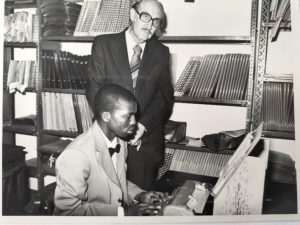
PHOTO Minister of National Education, the hon. WA Cruywagen with Mr. Richard Ndaba, African-language braille transcriber. Braille was written with a Perkins brailler onto a paper sheet, and duplication was done with a Thermoform duplicator onto special plastic sheets, before being bound into braille volumes. Until the early 1980s, most braille at Braille Services were produced in this manner. Photo: 1979
On 12 August 1993, the Gospel of Mark in Venda braille was handed to Ds Steff Boshoff, Head Secretary of the Bible Society of SA. During the hand-over, Mr Alson Tshisevhe (Venda-language braille proofreader), read a few verses from Mark 13 to the audience. A total of 25 copies were produced.
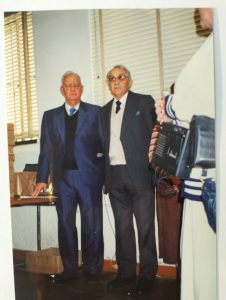
PHOTO Mr Ernst Kruger, executive director of Braille Services, with Mr PJ (Oom Doep) du Plessis, teacher at the Tshilidzini School for the Blind in Shayandima, Limpopo Province. Mr Du Plessis was the designer of the first TshiVenda braille system. Photo: circa 2000
The Move to Mayfair
The first permanent office of Braille Services was situated at Happiness House in Braamfontein, Johannesburg, which housed the braille printing operations from 1967 to 1979. The ever-increasing need for braille led to the acquisition of a church building in Mayfair, Johannesburg, and after extensive renovations, it was officially opened on 12 January 1979.

PHOTO SABWO Head Office (Photo: circa 1978) Blind SA occupied these premises from 1979 until we relocated to Alrode, Alberton in August 2021. The bell from the church tower is on display at the Blind SA head office in Alrode at the central staircase at reception.

PHOTO Ms Monica and Mr Ernst Kruger during the opening of the SABWO Head Office and Braille Services building in Mayfair on 12 January 1979. They are holding a portrait of Louis Braille, a gift from the SA National Council for the Blind.

Photo taken during the opening of the Braille Services building on 12 January 1979: (from left to right) Mayor of Johannesburg Clr. Dr. Otto, Ms Cruywagen, Minister Cruywagen, Mr Ernst Kruger, Mr Zeelie and Mr Mncube, the braille transcriber.
During the 1980s the demand for braille rose to the extent that the “Braille in Jail” project was launched, whereby a few carefully-selected prisoners were trained in braille transcription, first at Pretoria Central and later at Cullinan Prison. These volunteers were taught braille by Mr Esbie Burger from Blind SA’s Pretoria branch, and with the use of Perkins braillers, they transcribed a total of 103 books into braille. Proofreading was done by miss Krugel, a blind volunteer, and the completed books went to the SA Library for the Blind in Grahamstown.
Computerised Braille
With the aid of USA technology, Braille Services became the first printing house in South Africa to switch to computerised braille production. Collaboration between Prof. Solms, Department of Computer Sciences at Rand Afrikaans University (now University of Johannesburg), Ms Lettie van Tonder, computer scientist at UNISA, and Mr Joseph Sullivan of Duxbury Systems in the USA, the first automated Afrikaans braille translations were successfully completed on 1 February 1981. Soon conversion tables for African languages followed, and today Braille Services produce braille in 11 of the official languages.
The first electronic braille embossers used were the USA-manufactured Enabling Technology Company’s TED400 and Express150 machines, but in 2008 and again in 2012 Braille Services acquired the world’s fastest braille embossers, the Belgium-manufactured Interpoint55. Printing directly onto a paper reel, it can print more than a thousand braille pages per hour!

PHOTO The Belgium-manufactured Interpoint55 reel embosser
Another field of expertise is the production of tactile graphics – in the past hand-drawn or photostat swell-paper copies were produced, but in 2005 computer-generated graphic designs were introduced with Corel Draw and Tiger Pro tactile graphic embossers.
Over the years Braille Services was responsible for a number of “firsts”:
The braille edition of the “Constitution of South Africa”, produced in 1996;
Braille labels for lifts;
Braille business cards;
The Government Communications & Information Systems’ Vuk’uzenzele magazine; and
Information plaques for various botanical gardens all over South Africa.
In 2019 child-author Stacey Fru was assisted with the braille and DAISY-editions of her book “Tim’s answer” during the simultaneous launch of the print version.
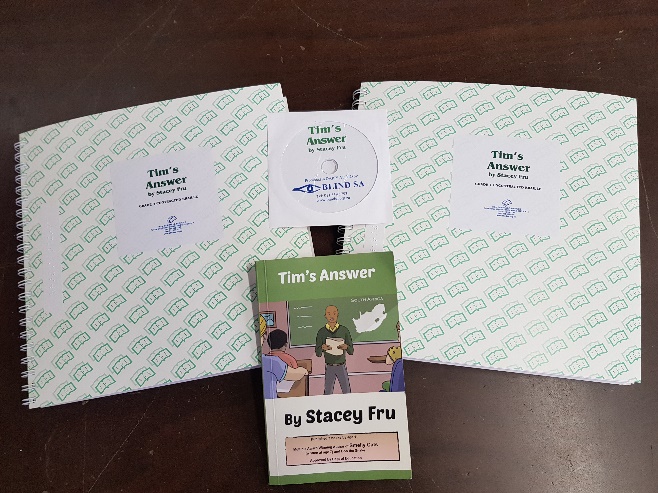
PHOTO The book “Tim’s Answer” by Stacey Fru, produced in braille and audio.
Another field of expertise is the repair and service of mechanical braille writing machines – the first Perkins brailler technicians were trained in 1997, and in 2019 another two technicians were trained to service and repair the TatraPoint brailler. To date, far in excess of 2 000 machines were serviced and repaired!

PHOTO The TatraPoint mechanical brailler, produced by Švec a spol. r.s.o. in Slovakia, imported into South Africa by Blind SA
In 2016 Braille Services expanded its scope of operation even further and acquired the skills to produce material in Daisy format. Apart from producing our magazines in this format, the first book to be produced in Daisy was Cry the Beloved Country by Alan Paton in early 2017. The establishment of the Blind SA Bookshare library provides the facility of making available material produced by Braille Services in Epub and braille formats.
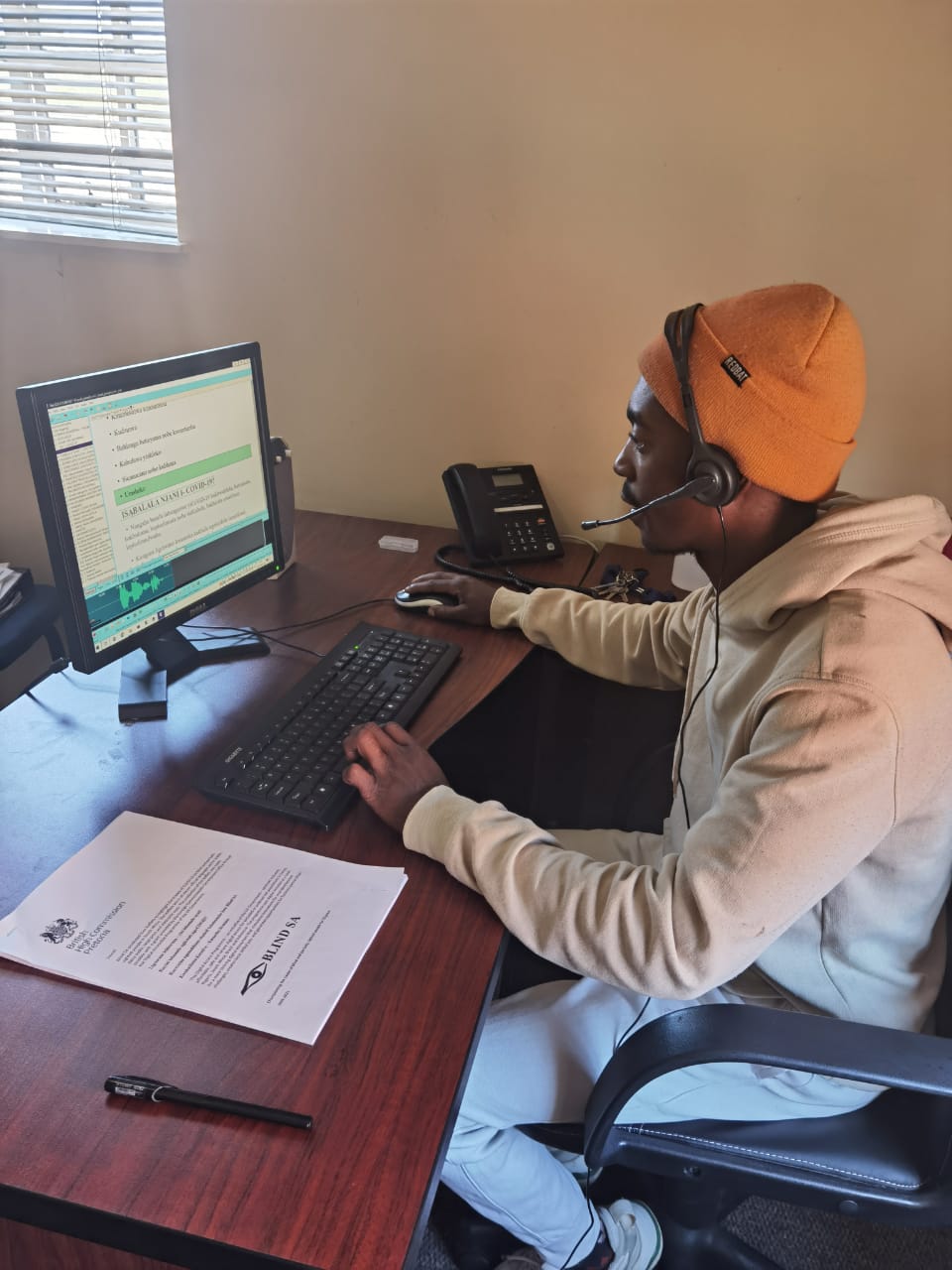
PHOTO The production of accessible material in electronic format, especially TTS Audio (computer-generated text-to-speech) is fast becoming increasingly popular.
Universal Ballot Template (UBT)
The UBT is an assistive device used by the visually impaired during the voting process whereby the ballot paper is fitted into this “sleeve” to assist them to vote in secret. The printing on the UBT is in large print for partially sighted voters, and the windows are marked with braille numbers.
In short the production process is as follows:
A ballot is designed by the IEC and from these specifications a graphics designer will develop a UBT. The “instructions for use” to the presiding officer is then developed by the IEC and printed on the UBT, as well as their logo and other identifying text. The required number is then printed onto the correct thickness and grade of paper board.
The die-cutting involve the cutting and creasing of the flat sheets, as well as cutting the correct number of voting windows, and the UBT is then separated from the flat sheet by hand.
The most technical process is the embossing of braille next to the different windows – numbering each one. This is done on a flat-bed hand-feed braille press, specially converted for this process. Each one of the 60 000 UBTs are machine-fed by hand and inspected for the correct braille placement and dot height.
Thereafter the UBT is folded and the two ends glued to form a “pocket’ or ‘sleeve’ – the voter will place the ballot paper into this pocket and mark the ballot in the window of his/her party of choice.

Our New Home
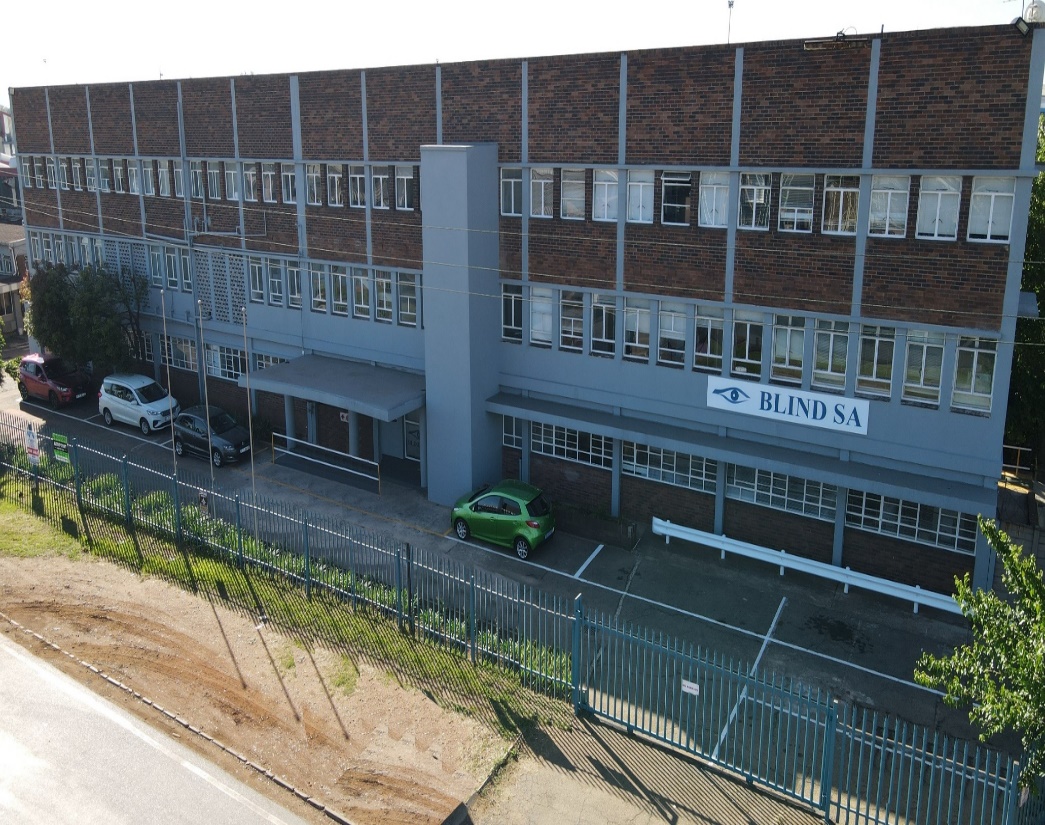
Blind SA relocated to 5 Fuchs Street, Alrode, Alberton in August 2021 – only the 3rd “home” in 77 years! Called Blind SA House, the 3 floors are taken up by the Braille Services and Skills Development divisions, ABBM (Antonnette Botha Braille Museum), as well as the Administrative division.

Photo: Blind SA Reception and Antonnette Botha Braille Museum entrance. The museum is open during normal Blind SA office hours
Comprising nearly 2000 m² floor space, it was officially opened during the festivities of Blind SA’s 75th anniversary on 26 October 2021, by our president, Mr Ntshavheni Netshituni.
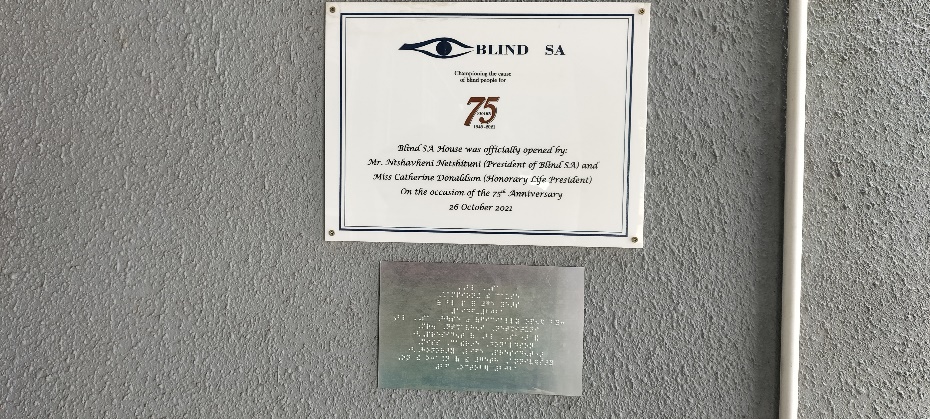
We Remember …
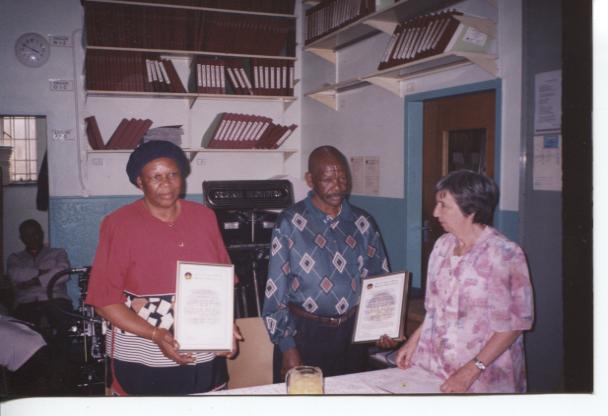
PHOTO Braille Service’s longest-serving couple – Mr Reuben and Ms Selina Radise. Both retired in 2000 – Reuben (Head-of-Department: Braille Printing) after 33 years and Selina (Print Proofreader) after 30 years of service! Ms Hazel Marshall, Blind SA president (1992-2004), handed over their Certificates of Appreciation.

PHOTO Mr Antonie Zeelie (10/01/1937-02/11/1996) On 1 August 1957 he joined the Môreligpers, the braille printing press of the School for the Blind in Worcester (today Pioneer Printers) as a braille transcriber. On 1 July 1963 he joined SABWO’s Braille Transcription Bureau as Head Printer, a position he occupied until his passing away on 2 November 1996.

“If we have no braille, we lose culture, we lose life,
we lose everything”
– Dr Walter Cohen, SABWO founding member and Braille Transcription Bureau chairman 1963-1980
Compiled by: JG (Stafie) Pelser, Daan van Niekerk and Philip Jordaan
Source: Droom tot Daad – geskiedenis van SABWO by Japie Mostert
Interviews with retired staff
Antonnette Botha Braille Museum archives and information brochures
